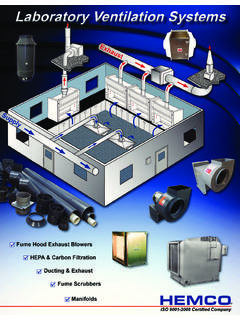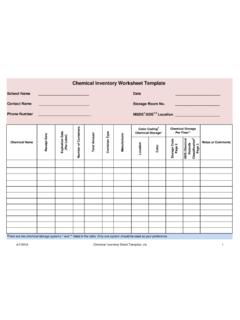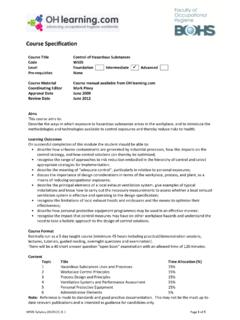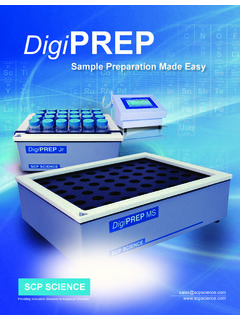Transcription of Chemical Resistance Chart - HEMCO Corporation
1 Chemical Resistance Chart UniFlow fume Hoods are constructed of white composite Fiberglass Reinforced Polyester (FRP) material. FRP is an excellent general purpose material for fume hood construction. HEMCO HiPel FRP composite fire resistant construction is classified for laboratory fume hoods. 1805. HEMCO HiPel FRP composite conform to NFPA 45 for products used in laboratories. Note: Any heat generating equipment should be elevated at least 3 inches above worksurface, and at least 3 inches away from side walls and baffle. Chemical Resistance of HEMCO 's most widely used FRP composite construction, and other liner material options. N = No Effect S = Slight Effect B = Bad Effect NA = Data Not Available Worksurfaces HEMCO High Polyvinyl Polypro- 304 Stain- 316 Stain- Epoxy Phenolic HiPel Density Chemical Chloride pylene less Steel less Steel Resin Resin FRP Polyethylene (PVC) (PP) (SS) (SS).
2 Composite (HDPE). Acetic Acid N N NA N S N N NA. Acetone N B N N N N N NA. Ammonium N N NA N N N N (28%) NA. Hydroxide Benzene N B S B N N N B. Carbon Tetrachloride N B B B N N N N. Chromic Acid N S NA B N N S (40%) B. Diethyl Ether N B NA B N N N NA. Ethyl Alcohol N N N N N N N NA. Gasoline N N B NA N N N N. Hydrogen Peroxide N N N N NA NA N B. Hydrochloric Acid N N N N B B S NA. Kerosene N N NA B N N N N. Methyl Alcohol N S N N N N N NA. Methyl Ethyl Ketone N B B NA N N NA N. Nitric Acid N (20%) N N B B B N NA. Sodium Chloride N N N NA S (10%) N (10%) S (10%) N. Sodium Hydroxide N N N N N N S (10%) B. Sodium Hypochlorite N N B N N N N NA. Sodium Sulfide S N N NA N N NA B. Sulfuric Acid N (33%) N (70%) N (80%) N S (80%) N (80%) N (60%) B (75%). Sulfuric Acid (conc.) S S S N B S B B. Flame Spread < 25 NA NA NA 0 0 NA NA. Fuel Contributed 0 NA NA NA 0 0 NA NA.
3 Smoke Developed 500 NA NA NA 0 0 NA NA. 34.







